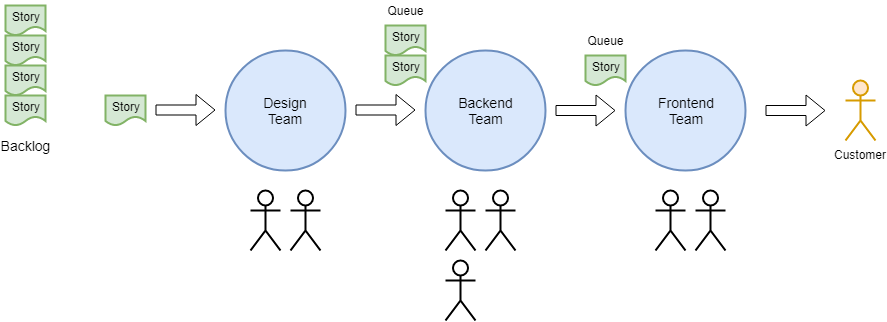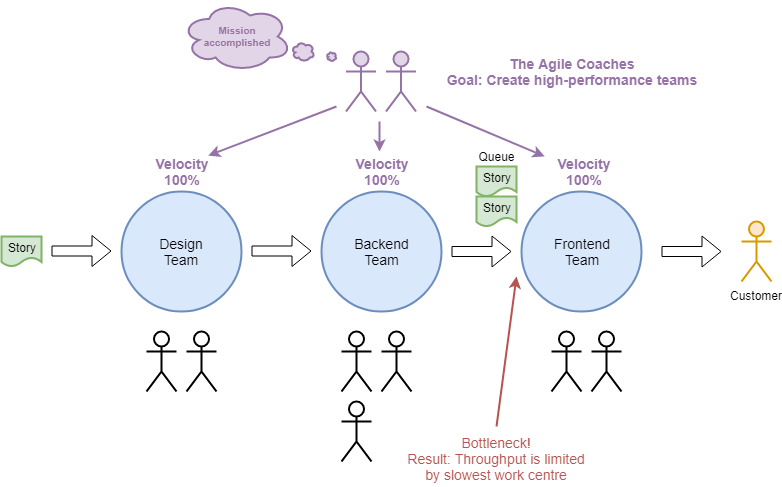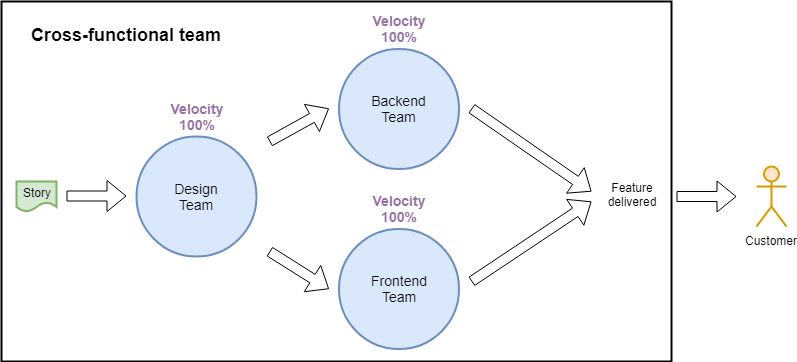Agile teams often use velocity as a metric to measure the team’s performance. This is a measure of the throughput of the team, how fast they are at delivering stuff. But this metric alone cannot be used to determine if the team are making customers happier or helping the company to make money.
To illustrate the problem let’s suppose we have three delivery teams in a chain. The first team pulls stories from the backlog and feeds them to the next team and so on until the feature is delivered to the customer. Throughput is low, so the company hires a couple of agile coaches to help the teams work more efficiently. Their goal is to:
Increase team velocity.
The coaches are good at their jobs, helping each team create INVEST-type stories, remove impediments, focus on delivering one thing at a time, CI/CD, etc. They soon maximise the team’s efficiency, realising their full potential, velocity reaches 100%, hurrah! But wait, there is still a bottleneck; the capacity of the FE team is limiting the flow of features to the customer. The queue of stories is also problematic as the all important shared understanding between teams is quickly lost as the wait-time between work centres becomes longer. What did the coaches miss?
What the scenario shows is that the Agile coaches cannot focus solely on the velocity of stories in the individual teams. It is still a useful measurement for planning team capacities, but the goal cannot be to maximise this value. If velocity can’t be used to solve the queue problem, then the coaches need another measurement that does. Observe that the wait-time between work centres delays the feature getting to the customer. In other words, wait-time adds to the total time needed to design, build and deliver features, i.e. it increases lead time. The coaches are given a new goal:
Increase team velocity while minimising the lead time for new features.
When should the coaches start measuring lead time? Probably from the time the company commits to delivering the feature. How do the coaches measure lead-time? Well, if the product owners are using a Kanban board for example, then they can just write the date on the card when they committed to building and delivering the feature. Then, when the feature begins its journey across the board the coaches can measure how long it took to reach the customer.
The coaches now have two conflicting metrics. On the one hand the team want to maximise their story velocity (local efficiency), but on the other hand the company wants to reduce time-to-market (TTM) (i.e. minimise lead time). (I am deliberating ignoring throughput which is the average time to deliver any feature. Even if throughput is high, it could still take months to deliver any one particular feature if the lead time is long. Thus, adapting to change becomes hard.)
Conclusion: the team must subordinate itself to the company’s goal. This means that if there is a downstream bottleneck (the FE team), then the BE team cannot keep pushing more work into their queue. In practice this means that the BE team cannot start a new story until the queue is cleared. The best way to manage this is using pull instead of push. If the BE team is finished with a story, then it is still included in their WIP limit (Work-In-Process rather than Work-In-Progress) preventing the team from starting a new story. When the FE team is ready to work on a new story they pull it from the BE team.
Do the BE team go home and wait for the FE team to pull the story? Ideally yes, in reality, no; there is always work to be done. Software systems pay a perpetual rent, what can be called maintenance debt, that must be continuously paid off to prevent the slow glide into non-compliance and obsolescence. In practice, the team should maintain a technical backlog of work that they can do while waiting for the bottleneck to pull work.
A more realistic scenario would be that the Design team releases the story simultaneously to the Frontend and Backend teams to work on. This is what happens in loosely-couple architectures; the two teams can agree on a contract and then work independently of each other to deliver their respective parts. This would improve lead time but there is still the problem of one team running faster than the other. What happens is that the bottleneck has moved to the end of the delivery process when the feature is delivered to the customer.
What more can our Agile coaches do to reduce lead times? Cross-functional teams are considered a good thing in Agile, can they help with reducing lead times? Let’s illustrate that in a completely new diagram.
What’s that? I just drew a box around the old diagram you say? OK, yes, I did. Instead of three separate delivery teams, we now have one product team. It’s still the same mix of competencies and the same system architecture, so why would we expect the delivery process to behave any differently?
So how is using a cross-functional team better? Well, the delivery teams now have a common goal that is set by the Product Owner. (The PO must express the company’s goal in terms that are meaningful to the team.) Also, the potential for collaboration and innovation, and the ability to “build the right thing” can be fully exploited. What about velocity and lead time? Maximising velocity now also means reducing lead time. Since there is one WIP limit for the whole team, there are no queues, further reducing lead time. Well done coaches!
OK, let’s take a step back. The coaches are now using two metrics to achieve the goal of reducing lead times efficiently. The new cross-functional team is pumping out features faster than ever. Are the customers happy? Is the company making more money? Eh, still no idea. How do we measure customer happiness or the return-on-investment for all the features the team is delivering?
The team must find some way to measure the effect a feature has on customer growth or customer retention, or increase in revenue, or whatever is important to the company. However, the team’s velocity enables it to fire off lots of features in rapid succession, making it impossible to know which features are actually the ones that are helping the team achieve its goal, and which are just adding to system complexity and maintenance debt. Let’s call this the feature success rate, i.e. what percentage of features released move the team towards their goal.
Once again there is a conflict between two metrics: velocity and feature success rate. The customers must be given the time to evaluate each feature in turn in order for the team to know if it was successful or not. So now the customer has become a bottleneck with a WIP limit = 1. How do we increase the customer velocity?
One way is to divide the customers into groups, so-called A/B testing with each group evaluating different features or different versions of the same feature. But this is the most expensive way for the team to find out if they have built the right thing. Instead the team should try to figure out as early as possible and as cheaply as possible if a feature will move the team towards their goal: customer surveys, impact mapping, wireframes, etc.; whatever it takes to validate assumptions while building as little as possible. Also, when choosing between features the team should pick those that have the biggest impact. For our intrepid Agile coaches the goal is finally expressed as:
Increase team velocity and minimise the lead time for new features while increasing feature success rate.
Summary
One surprising result of this analysis is that it is not possible, nor desirable, for developers to spend 100% of their productive time developing features. This is something every Product Owner for a cross-functional team must be aware of. This is due both to the capacity constraints of the different competencies in the team, the variance in the work itself, WIP limits and the bottleneck (wherever that happens to be in the flow).
Developers must maintain a technical backlog to work on when they are blocked by WIP limits or starved of new work. Like automated testing, developers must also spend time devising methods to measure the impact of whatever features they create. This holistic approach will also help the team members better understand the team’s goal.
The purpose of this analysis was to identify the goal for an Agile coach and to find the minimum number of metrics that the Agile coach needs, to know if they are moving towards their goal. My conclusion is that these metrics are:
- Team velocity to aid capacity planning and measure efficiency
- Lead time to shorten TTM and allow the team to adapt to change quickly
- Feature success rate to minimise the number of features used to meet the team’s goal
In short, the Agile coaches are moving towards their goal if the team’s velocity is increasing, lead time is reducing and feature success rate is increasing.
References
- The Goal by Eliyahu M. Goldratt
- GOTO 2012 • Frankenbuilds; if Agile is so good, why are our Products so bad? with Gabrielle Benefield



